How to Identify Chicken of the Woods (Laetiporus sulphureus)Identifying Chicken of the Woods is relatively easy once you know what to look for. Here’s a detailed guide to help you recognize this mushroom confidently, even without photos:1. Growth Habit:Chicken of the Woods grows in thick, overlapping clusters (called “shelves”) on tree trunks, logs, or stumps. These shelves can range from small clusters to masses over a foot wide, stacked like books on a shelf.2. Color:The most striking feature is its vibrant orange to salmon-colored top surface, often with bright yellow edges. The underside is uniformly pale yellow to white, depending on age. The colors may fade as the mushroom matures.3. Texture:When fresh and young, the mushroom feels thick, juicy, and soft — similar to cooked chicken breast. It becomes tough, dry, and crumbly as it ages. Always harvest only the young, tender portions.
4. Surface Appearance:The upper side is smooth and slightly velvety or suede-like to the touch. The margins (edges) are often wavy or slightly lobed.5. No Gills:Unlike many mushrooms, Chicken of the Woods does not have gills underneath. Instead, the underside is covered with tiny pores (hence it’s called a polypore). These pores release spores and look like a dense sponge.6. Smell:It has a mild, pleasant, and slightly lemony or mushroomy smell when fresh. If it smells sour or fishy, it may be too old.7. Location:Typically found on dead or dying hardwood trees, especially oak, cherry, or beech. Some species grow on conifers like pine or eucalyptus, but these are not recommended for consumption due to possible toxins absorbed from the tree.8. Season:Most commonly appears in late spring through early autumn, especially after warm rains.9. No True Stem:Chicken of the Woods grows directly from wood, without a traditional stem or stalk. The shelves are attached flat against the tree.10. Caution with Look-Alikes:There are few mushrooms that resemble it closely. However, always double-check the texture, growth pattern, and the absence of gills. When in doubt, consult an expert or local mycological group.How to Use Chicken of the Woods at Home1. Foraging TipsLook for clusters growing on hardwood trees, especially oaks.Only harvest soft, young growth — older mushrooms are tough and can upset your stomach.Always clean the mushroom well and avoid specimens growing on conifers or eucalyptus, which can absorb toxins.2. Cleaning the MushroomWipe with a damp cloth or rinse briefly under cold water.Pat dry and remove any tough or woody parts before cooking.3. Cooking IdeasSautéed “Chicken” StripsSlice into thin strips.Sauté in olive oil or butter with garlic, salt, pepper, and herbs.Optional: Add a splash of lemon juice or white wine.Chicken of the Woods SoupCube the mushroom.Sauté with onions and carrots, then add broth.Simmer with herbs and finish with a plant-based or dairy cream.Vegan “Chicken” TacosMarinate thin slices in lime juice, smoked paprika, garlic, and chili.Sauté and serve in tortillas with avocado and slaw.Breaded and FriedDip slices in seasoned flour or breadcrumbs.Shallow-fry until golden.Serve with your favorite dipping sauce.Grilled on SkewersThread pieces onto skewers with peppers and onions.Grill and baste with BBQ or teriyaki sauce.Mushroom JerkySlice thinly, marinate in soy sauce, maple syrup, garlic, and liquid smoke.Dehydrate or bake at low heat until chewy.Freezing for LaterLightly sauté first (blanching works too).Cool and pack into airtight containers or freezer bags.Keeps up to 6 months in the freezer.
Precautions:Always test a small portion first — some people experience gastrointestinal upset. Never consume wild mushrooms unless you’re 100% sure of identification.Disclaimer:This article is for informational purposes only and is not intended to diagnose, treat, or replace professional medical or foraging advice. Always consult a healthcare provider before consuming wild mushrooms, and never eat any wild mushroom unless it has been positively identified by an experienced mycologist.Chicken of the Woods offers a rare combination of culinary delight and nutritional benefit. With its vibrant appearance, meaty texture, and numerous health advantages, it’s a perfect wild food for both beginners and seasoned foragers. Once properly identified and safely prepared, it can become a rewarding addition to your kitchen and natural lifestyle.
